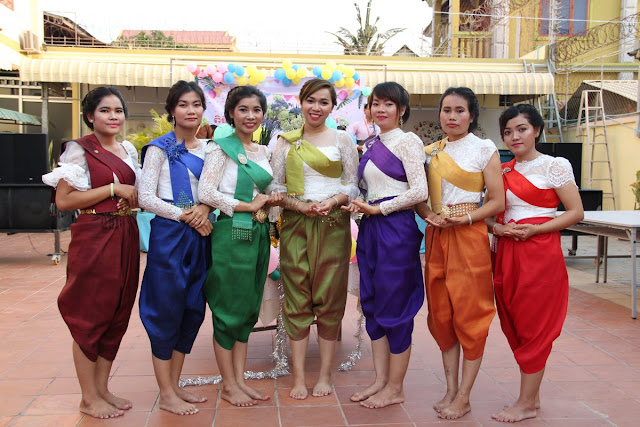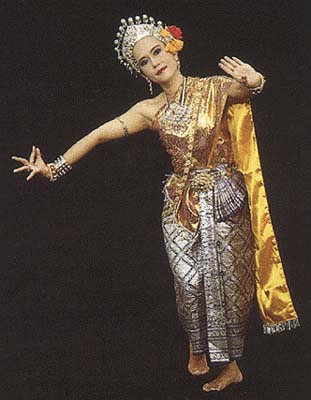Hello all,
Today I will talk a bit about the general costume of Southeast Asia. The map above shows the ethnic makeup of all of Mainland Southeast Asia, including Vietnam, Laos, Cambodia, Thailand, Myanmar, and the Chinese Provinces of Yunnan and Guangxi. You can see at a glance how complex the ethnolinguistic situation is. There are six major peoples in this area, and dozens of smaller ones. The dark green in the north represents the Han Chinese, and the pale green on the east coast represents the Kinh, or Vietnamese. I will deal with neither in this article. The dark brown in the south represents the Khmer, the fuschia to the north of that represents the Lao, as well as the Isan and Thai Yuan, the light brown on the southern coast represents the Central and Southern Thai, and the purple to the west represents the Bamar. These are the main ethnic groups of the states of Cambodia, Laos, Thailand and Myanmar, respectively. The Isan and Thai Yuan form part of the nation of Thailand, but are more closely related to the Lao linguistically; however they all speak Tai Languages.
You will notice that the regions inhabited by these peoples, and the minorities do not correspond well with the modern borders. These borders are the result of historical interactions between the King of Siam with the Colonial Empires of the region, Britain to the west, France to the east, and China to the north.
Each of these peoples has a long history, and can claim to have a high civilized culture. Just as the various states of Europe in the past shared high fashion, so these four states also share a basic traditional mode of dress, as well as the Buddhist faith, and other features of culture.
Here are some examples of the traditional fashion of this region.
This couple is Thai, and they are wearing a rich version of this basic dress. In Thai, this is called chut thai, ชุดไทย.
xout lao ຊຸດລາວ.
These people are Khmer.
As you can see, there are three basic pieces to this outfit, a top of some sort, a cloth which is wrapped around the lower part of the body, and another cloth which is often wrapped around the upper body.
The cloth which is wrapped around the lower body is called in Thai and Lao pha nung ผ้านุ่ง, in Khmer sampot សំពត់, and in Burmese longyi လုံချည်. Thai and Lao are closely related languages, but Burmese and Khmer each belong to a completely different language family. This basic garment is, of course, worn by other peoples as well.
This cloth is worn in three basic ways. Firstly simply wrapped around the body, as we see above. The second option is to sew the cloth into a tube, and then wrap it around the waist, this is somewhat more secure. In Thai and Lao, when the cloth is worn in this way it is called pha sinh. This is the most common method of wear among the Lao and in northern Thailand, especially among the Isan and the Thai Yuan.
The third way of wearing this cloth is to wrap it around the body with the ends in front, then twist the ends, pass them between the legs, and tuck them into the waist in back. In Thai this is called chong kraben โจงกระเบน, in Lao pha hang ຜ້າຫາງ, in Khmer sampot chang kben សំពត់ចងក្បិន, and in Burmese paso hkadaung kyaik. Most of the men shown above are wearing it in this way, but women wore this as well.
Some Khmer women
Thai men
Lao men
Bamar men playing a game.
The length of cloth worn wrapped around the upper body and hanging over the left shoulder is called pha biang in Thai - ผ้าเบี่ยง, and Lao - ຜ້າບ່ຽງ, or sabai, สไบ or ສະໄບ. In Khmer it is also called sabai - ស្បៃ. I have not been able to find the name of the garment in Burmese, but they also wore it for formal costume. Here is a historical photo of a Bamar woman.
And a contemporary one.
The following two photos are both Lao. The sabai may be worn over a blouse or other top, here a wrap around known as a suea pat.
Or it may be worn by itself with no other garment on the upper body. This is the original way in which it was worn.
In Khmer culture the sabai is connected to the legend of prince Preah Thong who clings to the sabai of a Nagini as she transports him to her land. Here are a couple of images of Khmer wearing sabai.
Thai women also wore the sabai with or without a blouse or jacket.
I will be writing much more about this region and its many peoples, for now I will close with some more images.
Bamar
Khmer
Lao
Thank you for reading, I hope that you have found this to be interesting and informative.
Roman K
email: rkozakand@aol.com



























































This comment has been removed by the author.
ReplyDelete